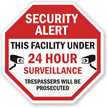Assessing the future of video surveillance
As events like the Boston Marathon bombings occur, people are becoming more amenable to video surveillance. Today, video surveillance is no longer limited to traditional security but is also found in retail, government, transport, and other areas. The video surveillance market is expected to grow by over 12 percent globally this year, as compared to 2013, according to research firm IHS. Here’s a look at the emerging trends in this increasingly omnipresent field.

Surveillance cameras monitoring the Olympic Athlete’s Village in Vancouver, Canada. From Paul Joseph.
Infrastructure improvements
According to IHS, Networked Internet Protocol (IP) video surveillance cameras are becoming more popular, as is the usage of cloud services, especially in China, where telecom infrastructure is resulting in faster speeds at lower prices.
The power of people
Another recent trend is the use of crowdsourcing and social media in surveillance, as was seen in the Boston Marathon bombing. Manufacturers will need to adapt systems to enable better analysis of images obtained by these means, says IHS.
Growth areas

This Electro-Optic/Infrared sensor camera used by the U.S. Navy provides 360-degree surveillance capabilities. From Office of Naval Research.
One area set for growth is uncooled thermal cameras. According to a report by Yole Développement, the decrease in demand for uncooled infrared camera in the military market has been partly compensated by the commercial and thermography markets.
Yann de Charentenay, senior analyst at Yole Développement, comments, “We are expecting 23% growth in shipments fueled by four key commercial markets showing a CAGR above 20%: automotive, surveillance, the young ultra-low-end thermography market, and finally by the rise of infrared imaging in smartphones.”
Another section expected to grow is the 180°/360° panoramic network camera. IHS predicts that growth in this field will be over 60 percent year-on-year, in global shipment units. These cameras work well in surveying large areas like airports, casinos, and stores.
Developments in supporting network infrastructure
Advances in related fields also impact video surveillance. Where traditional wiring for AC power is unavailable, Power over Ethernet (PoE) enables power to reach cameras using the same means by which data is transmitted. IHS expects manufacturers to tap into this technology by adapting their low-powered video surveillance cameras to the PoE+ level.
Machines to the rescue
Following the shooting at Sandy Hook, protection of employees and assets has become a higher priority. This has called for making live video surveillance from facilities available to the police.
Some schools have taken to the idea/ Glenbrook South High School in Cook County, Illinois, for example, will now be sharing the school’s live video surveillance during emergencies. Brian Wegley, principal of Glenbrook South High School, says, “We are putting this in place to ensure that all means are available to first responders.”
Emergence of the analytics market
Video surveillance analytics is expected to grow leaps and bounds in the coming years—from $7.5 billion in 2012 to an estimated $21 billion by 2020. Technology research firm ABI has declared video surveillance analytics to “have matured to the point of practicality.”
The rapid growth of the intelligent video surveillance industry is governed by increasing demand, decreasing costs, cutting-edge technologies, and a high rate of overlooked events by human operators.
Hear, hear: Popularizing the audio feature
Though audio could play a larger part in video surveillance, the sound capabilities of network cameras have largely gone unexplored. However, IHS predicts that embedded audio analytics and sound-source localization features are gaining momentum and will be garnering customers’ interest in the new year.
Category: News, Surveillance, Technology















